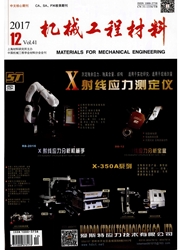

 中文摘要:
中文摘要:
对铸态Mg-5Zn-1Mn-xSn(x分别为0,0.3,0.6,0.9,质量分数/%)合金进行了330℃×24h+400℃×2h的均匀化处理,然后在应变速率为9.1s^-1条件下轧制成厚度为2 mm的合金板,研究了锡添加量对铸态和轧制态合金显微组织和拉伸性能的影响。结果表明:锡的添加可以细化试验合金的铸态及其均匀化处理后的显微组织,并形成高熔点Mg2Sn相,促进后续轧制过程中试验合金的动态再结晶并细化晶粒;经轧制后,试验合金的拉伸性能优于其铸态的,且随着锡含量的增加,轧制态合金的强度与塑性呈先上升后下降的变化趋势,其断裂形式从准解理断裂逐渐向延性断裂转变;Mg-5Zn-1Mn-0.6Sn合金的拉伸性能最佳,其抗拉强度和伸长率分别为337MPa和21%。
 英文摘要:
英文摘要:
The as-cast Mg-SZn-Mn-xSn ( x = 0, 0.3, 0.6, 0.9, mass fraction/%) alloys were homogenized with process of 330℃×24h+400℃×2h, and then rolled into 2 mm thick alloy plates at the strain rate of 9.1 s^-1. The influence of Sn addition on the microstructures and tensile properties of as-cast and as-rolled alloys was studied.The results show that the Sn addition can refine the microstructure of the as-cast alloys and homogenized alloys, leading to the formation of the Mg2Sn phase with high melting point, which can promote the dynamic recrystallization and refine the grain size during the subsequent rolling process. After rolling, the tensile property of the tested alloy was better than that of as-cast alloy. Meanwhile with the increase of Sn content, the strength and plasticity of as-rolled alloy first increased then decreased, and the fracture mode transformed from quasi-cleavage fracture to plastic fracture. The tensile property of Mg-5Zn-1Mn-0.6Sn alloy was the best with the tensile strength and elongation of 337 MPa and 21%, respectively.
 同期刊论文项目
同期刊论文项目
 同项目期刊论文
同项目期刊论文
 期刊信息
期刊信息
